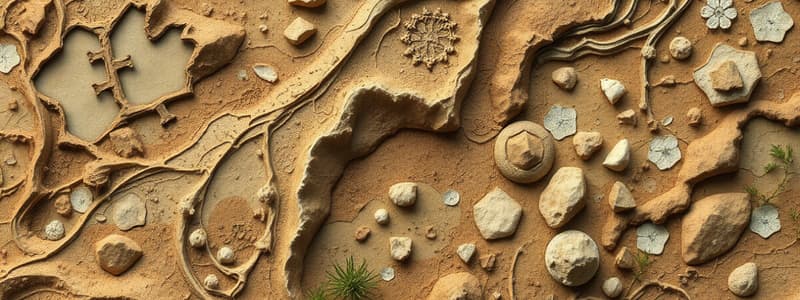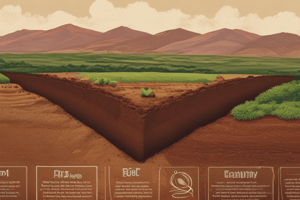Podcast
Questions and Answers
What is the primary factor influencing soil formation?
What is the primary factor influencing soil formation?
- Weathered rock material
- Topography
- Vegetation
- Nature of the parent rock (correct)
Which of the following is NOT a factor in soil formation?
Which of the following is NOT a factor in soil formation?
- Climatic factors
- Time for composition
- Presence of topsoil (correct)
- Role of organic material
How long does it take to form just one centimeter of soil?
How long does it take to form just one centimeter of soil?
- A few days
- Hundreds of years (correct)
- One year
- Several months
Which of the following factors can vary significantly from one location to another affecting soil composition?
Which of the following factors can vary significantly from one location to another affecting soil composition?
What is the purpose of intercropping?
What is the purpose of intercropping?
Which component is found in the subsoil layer?
Which component is found in the subsoil layer?
What does contour ploughing achieve?
What does contour ploughing achieve?
In which areas are shelter belts most commonly utilized?
In which areas are shelter belts most commonly utilized?
What is the main component of the activity involving trays A and B?
What is the main component of the activity involving trays A and B?
What is the main objective of planting trees in shelter belts?
What is the main objective of planting trees in shelter belts?
What is one way that plants protect the environment?
What is one way that plants protect the environment?
Which of the following is NOT a product derived from plants?
Which of the following is NOT a product derived from plants?
What essential role do plants play in the ecosystem concerning oxygen?
What essential role do plants play in the ecosystem concerning oxygen?
Which of the following functions do plants serve in relation to water?
Which of the following functions do plants serve in relation to water?
How do plants contribute to the food supply for humans?
How do plants contribute to the food supply for humans?
What is one of the primary causes of forest fires mentioned?
What is one of the primary causes of forest fires mentioned?
Which of the following is a control measure for preventing forest fires?
Which of the following is a control measure for preventing forest fires?
What impact do human activities have on the environment according to the content?
What impact do human activities have on the environment according to the content?
Which of the following is NOT listed as a reason for forest fires?
Which of the following is NOT listed as a reason for forest fires?
How can prompt detection of fires be achieved, as discussed?
How can prompt detection of fires be achieved, as discussed?
What is the primary purpose of laws passed in several countries regarding birds and animals?
What is the primary purpose of laws passed in several countries regarding birds and animals?
What role do awareness programs like social forestry play in conservation efforts?
What role do awareness programs like social forestry play in conservation efforts?
Which of the following species is specifically mentioned as being illegal to kill in India?
Which of the following species is specifically mentioned as being illegal to kill in India?
What is CITES, as referenced in the content?
What is CITES, as referenced in the content?
How are school children encouraged to contribute to wildlife conservation?
How are school children encouraged to contribute to wildlife conservation?
Flashcards are hidden until you start studying
Study Notes
Soil Formation
- Major factors influencing soil formation include the nature of the parent rock, climate, topography, organic material, and the time required for soil composition.
- Soil development can take hundreds of years, with only one centimeter of soil forming in that duration.
Soil Conservation Techniques
- Intercropping: Planting different crops in alternate rows and at varied times to prevent soil erosion.
- Contour Ploughing: Ploughing along the contours of hills to create barriers that slow down water runoff and minimize erosion.
- Shelter Belts: Rows of trees planted in coastal and dry regions to reduce wind erosion and protect soil integrity.
Importance of Plants
- Plants contribute timber, oxygen, and fruits; they are essential for agriculture and provide shelter for wildlife.
- Many plants have medicinal uses and produce resources like latex, turpentine, oil, and paper.
- Trees play a critical role in conserving underground water and maintaining ecological balance.
Wildlife and Ecosystem
- Wildlife encompasses various species, including mammals, birds, insects, and aquatic life, that are vital for ecological balance.
- Human activities significantly disrupt habitats, leading to the depletion of animal populations and extinction of some species.
Forest Fires
- The primary causes of forest fires include natural events (like lightning), human negligence, and intentional acts by individuals.
- Control measures for forest fires involve education on prevention, early detection through monitoring systems, and efficient communication networks.
Conservation Efforts
- Laws exist globally and in India to protect endangered species like lions, tigers, and peacocks; trade in these species is prohibited.
- Awareness programs such as social forestry and nature camps can foster appreciation of biodiversity among youth.
- International conventions like CITES prohibit the trade of numerous endangered species to preserve ecological integrity.
Ethical Responsibility
- Conservation of flora and fauna is considered an ethical obligation for society, emphasizing the importance of sustainability for present and future generations.
Studying That Suits You
Use AI to generate personalized quizzes and flashcards to suit your learning preferences.




